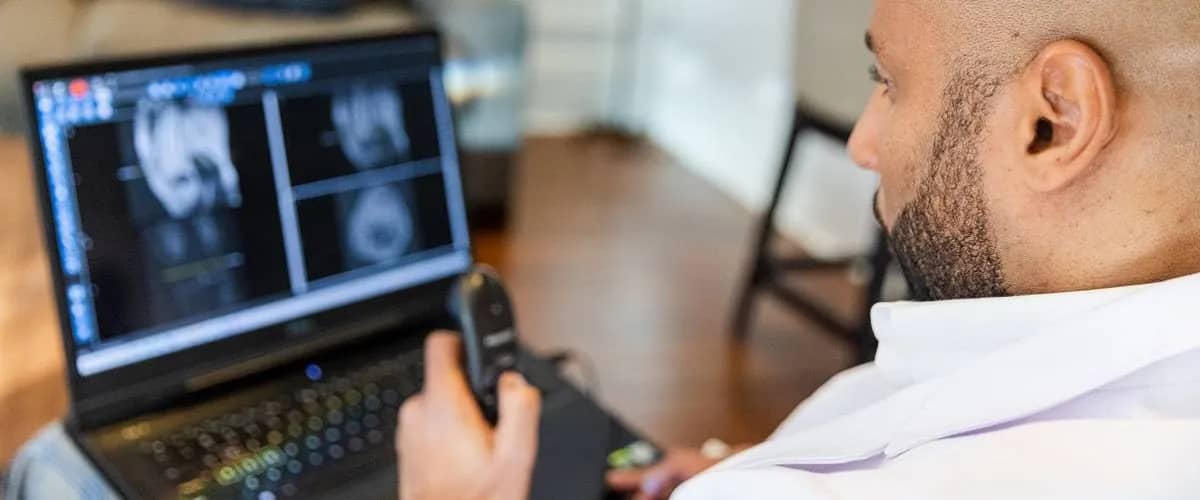Teleradiology plays a crucial role in diagnostic medicine. As technology advances, the demand for specialised diagnostic services will continue to grow, and this tool will likely become increasingly important in delivering these services to patients in remote areas.
📖 Author: Emmanuel Anyanwu | Alberta Health Services, Canada
Some of the ingenious and innovative solutions that have revolutionised the healthcare industry through the advancement of technology have transformed modern medicine, and radiology has significantly benefited from these incredible breakthroughs. An innovative solution that has impacted the world of diagnostic imaging is teleradiology, which refers to the use of technology to electronically transmit digitised radiological images and related patient information between different locations for diagnosis and consultation.
Importance of teleradiology
Teleradiology has been crucial for radiologists, healthcare providers, and patients, especially during the Covid-19 pandemic era. “So, when Covid-19 hit, almost all of our faculty had home workstations. With the framework in place, it was relatively easy to transition to a remote reading model, with the exception of breast imaging, due to the technical requirements. Since Covid-19 began, one radiologist works in the onsite reading room while all other radiologists read remotely at home,” said Dr Jules Sumkin, DO, chairman of the Department of Radiology at UPMC.
There are several reasons why teleradiology is essential, and some of them include the following:
- It enables radiologists and other physicians to learn more, develop their abilities within the field, and even for student doctors to enjoy lectures and demonstrations from experts.
- It allows patients to have a second opinion from other radiologists about their diagnostic results.
- Sometimes, researchers may require the input of radiologists for research studies, and teleradiology allows this to happen without the need for either the researcher or radiologist to travel to get that information.
Advantages of teleradiology
Diagnostic imaging departments or centres, as well as patients, have greatly benefited from teleradiology, and some advantages include:
- Improved access to specialised expertise: With teleradiology, radiologists can interpret medical images remotely and share their findings with physicians and other healthcare providers in different locations. This means that patients in rural or remote areas can receive specialised diagnostic services without travelling long distances.
- Faster turnaround time: Radiologists can review and interpret images in real time, allowing for more rapid patient diagnosis and treatment. To improve operational efficiency, radiologists can use teleradiology to collaborate better with healthcare providers, as multiple specialists can easily share and review images.
- Reduced costs: Granting radiologists the opportunity to work from any remote location removes the need to travel to the area where the patient image was captured, leading to saving costs. Additionally, teleradiology may eliminate the need for a full-time in-house radiologist since this tool allows radiologists to read and interpret diagnostic imaging seamlessly.
- Patient satisfaction: One fulfillment of any hospital or imaging centre is patient satisfaction. Ensuring patients don’t have to wait to get the results of their diagnostic tests because teleradiologists can consult and give their opinions is a vital way to provide quicker diagnosis and better patient care.
- Collaboration: Teleradiology affords radiologists a great platform to collaborate and learn from each other. It also provides room for a professional second opinion on diagnostic scans since patient data is digitised, providing patients with the best care.
The MD, chairman of the Department of Radiology, THR Presbyterian Hospital Plano/TX, and chief technology officer at TRA, Dr. John Y. Kim said, “Even our referring physicians are practicing a lot more telemedicine. So as staff gets more used to teleradiology and to telemedicine in general—and it becomes more acceptable to hospitals, referring physicians and patients—it will become more of a standard way of practicing medicine.”
Challenges of teleradiology
Despite how important it is, teleradiology also poses some challenges. One of the main challenges is ensuring the security and privacy of patient information during transmission and storage. Healthcare suppliers must provide appropriate protocols and safeguards to protect patient data from unauthorised access or disclosure.
Another challenge is the potential for misinterpretation of images due to equipment or image quality differences. Healthcare providers must ensure that images are of diagnostic quality to enable accurate interpretation and to carefully evaluate and implement appropriate protocols and safeguards when using teleradiology technology.
In conclusion, teleradiology is an important telemedicine branch that can potentially improve patient outcomes and increase access to radiological services. The benefits of teleradiology are clear, and continued technological advances are likely to further enhance its effectiveness and utility in the years to come.
—
Is there anything to add from your side on the importance of teleradiology? Share your thoughts via the comment section below.
Want to join a great team? Check out our careers section. We are always looking for outstanding talent—from application specialist to software developers.



